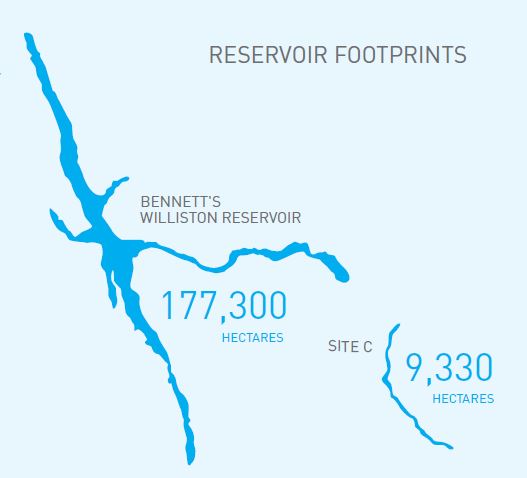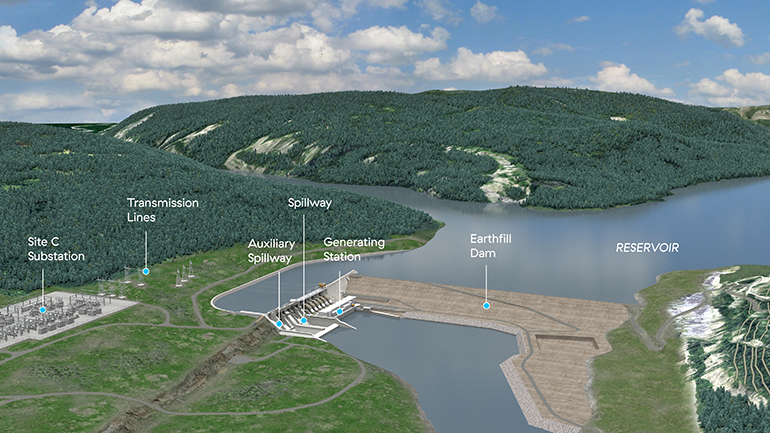Overview nav
Project Overview
The Site C Clean Energy Project will be a third dam and hydroelectric generating station on the Peace River in northeast B.C. It will provide 1,100 megawatts (MW) of capacity, and produce about 5,100 gigawatt hours (GWh) of electricity each year – enough energy to power the equivalent of about 450,000 homes or 1.7 million electric vehicles per year in British Columbia.
About Site C

The Site C Clean Energy Project will be a third dam and hydroelectric generating station on the Peace River in northeast B.C. It will provide 1,100 megawatts (MW) of capacity, and produce about 5,100 gigawatt hours (GWh) of electricity each year – enough energy to power the equivalent of about 450,000 homes or 1.7 million electric vehicles per year in British Columbia.
As the third project on one river system, Site C will gain significant efficiencies by taking advantage of water already stored in the Williston Reservoir. This means Site C will generate about 35 per cent of the energy produced at W.A.C. Bennett Dam, with only five per cent of the reservoir area.
In December 2014, the Site C project received approval from the provincial government to proceed to construction.
This decision followed a rigorous and independent environmental assessment by the federal and provincial governments, which included a Joint Review Panel process. The conclusion of the three-year environmental review was that the effects of the Site C project are justified by the long-term benefits it will provide
Construction started in summer 2015, and the project is on track to have all six generating units fully in-service by November 2025.
Once built, Site C will be a source of clean, reliable and affordable electricity in B.C. for more than 100 years.
The project design for the Site C Clean Energy Project includes the following key components:
- Access roads in the vicinity of the site and a temporary construction access bridge across the Peace River at the dam site.
- Construction of two temporary cofferdams across the main river channel to allow for construction of the earthfill dam.
- Worker accommodation at the dam site, with other workers being housed off site and in the region.
- The realignment of six segments of Highway 29 over a total distance of 30 kilometres.
- Shoreline protection at Hudson's Hope.
- Two new 500 kilovolt AC transmission lines that will connect the Site C facilities to the existing Peace Canyon Substation, along an existing right-of-way.
- An 800-metre roller-compacted-concrete buttress to enhance seismic protection.
- An earthfill dam, approximately 1,050 metres long and 60 metres high above the riverbed.
- A generating station with six 183 MW generating units.
- An 83-kilometre-long reservoir that will be, on average, two to three times the width of the current river.

While the demand for electricity fluctuates year-to-year, we forecast that B.C.'s electricity needs will grow by almost 40 per cent over the next 20 years, driven by a projected population increase of more than one million residents and economic expansion. Growth in electrification and electric vehicles will further increase demand.
As extensive as our electricity supply is, and even with our ambitious conservation programs, it will not be enough to meet B.C.'s long-term electricity needs. That's why we're reinvesting in its existing assets and building the Site C Clean Energy Project. New resources are required to meet long-term electricity needs in B.C.
Our long-term energy planning process has found that Site C provides the best combination of financial, technical, environmental and economic development attributes compared to other electricity-generation options.
The Site C project will provide key benefits for B.C., including energy, dependable capacity and flexibility, regional economic development, job creation, and benefits communities and Indigenous Nations.
Project Attributes:
- Site C will provide 1,100 megawatts of capacity, and produce about 5,100 gigawatt hours of electricity each year — enough energy to power the equivalent of about 450,000 homes or 1.7 million electric vehicles per year in B.C.
- It will be a source of clean and renewable electricity for more than 100 years.
- Site C will have among the lowest GHG emissions, per gigawatt hour, compared to other resource options.
- As the third project on the Peace River, Site C will rely on the existing Williston Reservoir for water storage. This means Site C will generate about 35 per cent of the energy produced at the W.A.C. Bennett Dam, with only five per cent of the reservoir area.
- Site C will be among the most cost-effective resource options for our ratepayers.
- Site C will create about 13,000 person-years of direct employment during construction.
- Construction also provides significant opportunities for businesses of all sizes.
- Construction will contribute $3.2 billion to provincial GDP, including approximately $130 million to regional GDP.
- During construction, Site C will result in a total of $40 million in tax revenues to local governments and, once in operation, $2 million in revenue from grants-in-lieu and school taxes.
- Site C will be a source of affordable power to meet B.C.'s future electricity needs, and we expect to require the energy and capacity from Site C by about 2030.
While the demand for electricity fluctuates year-to-year, we forecast that B.C.'s electricity needs will grow by almost 40 per cent over the next 20 years, driven by a projected population increase of more than one million residents and economic expansion. An emerging Liquefied Natural Gas (LNG) sector and growth in the use of electric vehicles would further increase demand in the future.
As extensive as our electricity supply is, and even with our ambitious conservation programs, it will not be enough to meet B.C.'s long-term electricity needs. That's why we're reinvesting in its existing assets and building the Site C Clean Energy Project. Learn more about the need for long-term energy in B.C.